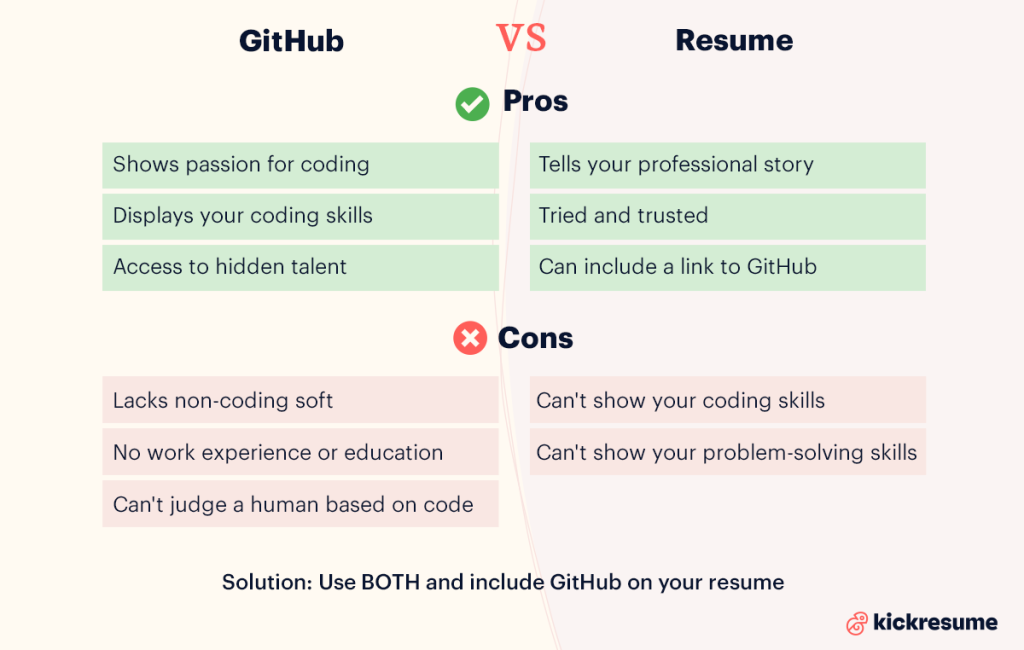It's no secret that the world of recruitment has changed in the last few years. LinkedIn profiles, online portfolios, and even what you post on social media have become big deal makers (or breakers).
GitHub — which is really like a portfolio for your code — has been on the hiring radar too.
With these changes, some may be tempted to ask, 'Is GitHub about to replace traditional resumes?' The short answer: no.
Even with all of these "tools" available, no one has ever stopped attaching resumes to their job applications. And there's a pretty good reason why. (But we'll get to that.)
While GitHub has become a cool tool to use when hunting for software developers, some discussions tend to overhype its significance in a quest to make it 'the next big thing' kind of story.
So, what's the real deal with GitHub in the hiring scene?
- Is GitHub meant to replace your resume?
- How can you actually include GitHub on resume?
- How can you best format it?
- How do you prepare your GitHub for public visibility?
In this article, we're answering all these questions.
Our verdict: Don't make it a choice between GitHub or a resume — use BOTH to your advantage. We'll show you how.
Benefits of GitHub
So, the first question begging to be answered is: why do employers even ask for your GitHub profile?
Employers aren’t just being snoopy, nor are they trying to add another hurdle in your job application process. They have some legit good reasons, let's dive into some:
- It shows passion. Employers love seeing passion. And you, coding away in your free time and contributing to open-source projects on GitHub, shows just that — a desire to engage with your field outside the traditional workday.
- Coding skills IRL. Your resume spells out your capabilities, but GitHub is where employers get to see your coding skills in action. Here, they gain insights into your approach, problem-solving, and how the GitHub community engages with your work.
- Access to passive talent. The most in-demand talent often aren't actively job seeking. They're the 'passive talent.' Employers fishing in the GitHub pool hope they might reel in one of these big fish.
- Reveals excellent problem-solvers. Your GitHub provides the key to one more thing that's a biggie for employers: problem-solving skills. Your resume can be bursting with all the keywords and qualifications, but if you can't problem-solve effectively, it's a problem. Your GitHub can show off the clever ways you've navigated around coding roadblocks and impress potential employers.
In spite of its many strengths, a GitHub profile can only provide employers with a limited picture of a candidate’s abilities.
Ultimately, GitHub isn’t the new resume. Similarly to the resume, it has its limitations and neither is very useful without context. Why?
Limitations of going all-in with GitHub
While GitHub is popular in the programming world, it isn't the greatest tool for recruitment purposes.
Here's why:
- Impersonal side of GitHub. Is hiring just about code and nothing else? Nope. The total GitHub reliance can bring out a cold, impersonal side to the hiring process since it replaces human stories with lines of code. Remember, employers are out to hire people, not just a set of coding skills.
- Lacks non-coding skills. Your leadership skills, your knack for effective communication, your ability to cooperate — these are the soft skills that a GitHub profile doesn't show.
- No work experience or education. While GitHub may do a bang-up job showcasing your projects, it doesn't describe your professional journey as effectively as a resume. Complete work histories, with all the details of roles, responsibilities, and successes, get lost.
- You can go unnoticed. GitHub revolves around how others perceive you. It doesn’t let you value your work for yourself. For this reason, many great developers might go unnoticed while gifted influencers can get a lot of credit even for the smallest of contributions.
- Public vs private contributions. Remember, not all your GitHub work sees the light. Unless you're knee-deep in open-source development, many of your projects may remain hidden from view. This visibility hitch, inherent in GitHub, isn't a challenge with a comprehensive resume that highlights all your accomplishments.
- Lack of project context. GitHub displays a broad spectrum of your projects, from the serious to the experimental, or even joke codes. Without context on each project's intent, recruiters may misunderstand your skills and expertise.
Yet, in spite of its shortcomings, GitHub can still be a very helpful in the job search process.
You just shouldn't put all your eggs in that one basket. Let us tell you why.

Resume vs. GitHub: Who wins?
When we stack GitHub against resumes, do we have a clear winner? We kind of do.
Here's why the good old resume still gets the gold medal:
- Tried and trusted. Resumes are universally accepted within hiring processes. They provide a quick snapshot of your career, fast-tracking your application through initial HR screenings.
- Provides the full package. Your resume includes personal information, hard and soft skills, and your professional experience. It also talks about your certifications, languages you speak, recognitions, and awards won. Something that a GitHub profile can't do.
- Paints your professional picture. Through detailing your roles, responsibilities, and successes, your resume provides a story arc to your career that GitHub can’t.
- Recruiters/HR people usually can't code. Last but not least, it's usually not the software engineers and coders who source people and do initial interviews. Rather, it's the recruiters or HR managers. And these people probably won't understand the code anyway. They do, however, understand resumes.
That being said, let's not rule GitHub out altogether.
It's increasingly critical to demonstrate hard technical skills and active engagement in coding. After all, you still can't show your actual code in a resume.
While it might be tempting to pit one against the other, a more productive perspective is to view both as complementary.
The resume introduces and presents you professionally, while GitHub validates and adds depth to your claimed technical skills.
The question is: how do you present both GitHub and a resume at once to a recruiter?
The answer is actually really easy: you simply include your Github on a resume.
So, let's talk about how to do that professionally.

How to put GitHub on your resume
Now that we know why it's essential to combine the best of both worlds, let's discuss how to properly put GitHub on a resume:
- Link your GitHub profile in the contact information section.
This highlights its importance righ off the bat. Simply copy and paste your profile URL.
- Showcase your best project.
Instead of flooding with numerous projects, focus on the 1-2 you're most proud of. That's what recruiters will look into.
- Include a project-specific URL in a separate section.
Highlight a specific project URL under a separate "projects" section. This means not just your general GitHub profile, but a direct link to a project you particularly excel at.
- Describe the project in more detail.
If you listed project separately, don’t just leave it at the URL. Accompany it with a few bullet points explaining your work. Let employers know what the project is about, your contribution, the technologies used, etc.
That said, creating a bridge between your resume and GitHub is only half the battle…
Preparing your GitHub for the recruiters' eyes
Once your GitHub profile is accessible from your resume, expect potential employers (or the coders they call in for an expert opinion) to take a peek — and you must be ready for that scrutiny.
Here are our top six tips for preparing your GitHub for visitors:
- Improve your directory structure. It all begins with a first impression, and for GitHub, that's your directory structure. Adhere to Simple Folder Structure Conventions. This gives employers a sense of your architectural proficiency without diving deep into your code.
- Include an informative README. Your README should be a roadmap of your project. It must describe the application's functionality, explain how to run, build and test it, and provide relevant visuals. Make sure it's comprehensive but succinct.
- Prioritize clean, commented code. Making your code clean and easy to read is crucial. It's good practice to comment properly, anticipating that someone might deep-dive into your code.
- Use existing libraries and frameworks. Efficiency matters. Avoid reinventing the wheel and show that you can smartly deploy open-source solutions for common problems or routines.
- Avoid code repetition. Repeating blocks of code? Steer clear of them. Find more elegant, efficient solutions. It's not just about getting the code to work, but making it sharp and clean.
- Include tests. Make a strong case for your thoroughness by including a test suite. Guidance in your README on how to run it can further impress recruiters. For bonus points, integrate your repository with a Continuous Integration (CI) system. This proactiveness bodes well with potential employers.
Key takeaways: GitHub vs. resume (or rather GitHub on resume, heh)
So, is GitHub replacing resumes? Hardly.
While GitHub is still just an optional component of the hiring process, resume remains essential to it.
Instead of having one or the other, recognize their complementary strengths and have both. The resume does a stellar job of showcasing your career timeline, your accomplishments, and full skill set, while GitHub offers a practical demonstration of your coding hard skills.
That said, here's a recap of what you should do (the gameplan, if you will):
- Include GitHub on your resume. Share your profile link in the contact section, showcase your prime project in a separate "projects" section, and describe the project to give context.
- Prepare your GitHub for the public eye. Optimizing your GitHub profile involves creating a user-friendly directory structure, crafting a comprehensive README, maintaining clean, well-commented code, using existing frameworks, avoiding code repetition, and including test suites.
- Update your resume. Lastly, show some love to your resume. We get that you probably hate writing your resume, but our ultimate resume guide will provide a helping hand.
Oh, and if you reaaally feel stuck on creating your resume, try having AI write the first draft for you in seconds.
This article was recently updated. The original article was written by Martin Poduska in 2017.



